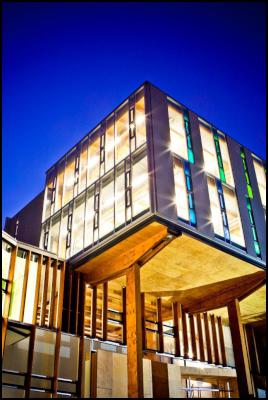Local low-damage seismic design leads the pack
Media Release, EXPAN, August 2012
Local low-damage seismic design leads the pack

New Zealand knows all too well the economic and social costs of building design that stands up to an earthquake, but sees the building subsequently demolished.
And a locally developed timber building system that enables fast re-occupation after an earthquake has emerged as world-leading at a recent gathering of international timber engineering experts.
The World Conference of Timber Engineering (WCTE) was held last month in Auckland, bringing together more than 500 researchers, engineers and designers in a global forum of research, innovations and developments.
Standing tall amongst the hundreds of presentations was research from the Structural Timber Innovation Company, (STIC), a research consortium made up of New Zealand and Australian commercial and academic partners.
STIC is behind the development of EXPAN – a unique post-tensioned laminated veneer lumber (LVL) (or glulam) building system that offers superior seismic qualities and lateral stability for multi-storey buildings. In the event of an earthquake, an EXPAN building stays structurally intact through a controlled rocking mechanism and timber components that give strength without weight to minimise acceleration loads caused by ground shaking.
Professor Pierre Quenneville, STIC Research Team Leader and WCTE Technical Programme Chair, says he received numerous comments at the conference that New Zealand is leading the way in timber engineering.
“The rest of the world is now waking up to New Zealand’s recent advances in low-damage seismic design of timber structures. Much of the design philosophy in other countries is still based around an acceptance of some structural failure, where people get out safely in an earthquake, but the building is not able to be saved, or major repairs deem it unusable for a long time. It was clear from the conference that the EXPAN building system is currently the only one in the world that offers the certainty of low-damage design using engineered timber.”
STIC Chief Executive Dr Robert Finch says it’s fantastic to see New Zealand leading the world in this hugely significant area.
“As we see thousands of buildings being demolished in our second largest city, this design philosophy becomes ever crucial. Commercial building owners, and tenants, no longer need to accept that a major earthquake means they’ll be out of their building for a long period of time, or not get back in at all. Here we have a comprehensively-researched, proven damage-avoidance seismic technology that enables buildings to remain serviceable after a sizeable quake.
“Massey University’s CoCA building has just become the seventh building in the country to utilise this cutting-edge building system, and we’re looking forward to seeing Christchurch’s first two EXPAN buildings go up in coming months.”
ends


 Business Canterbury: Urges Council To Cut Costs, Not Ambition For City
Business Canterbury: Urges Council To Cut Costs, Not Ambition For City Wellington Airport: On Track For Net Zero Emissions By 2028
Wellington Airport: On Track For Net Zero Emissions By 2028 Landcare Research: ANZAC Gall Fly Release Promises Natural Solution To Weed Threat
Landcare Research: ANZAC Gall Fly Release Promises Natural Solution To Weed Threat NZ Anti-Vivisection Society: Auckland Rat Lovers Unite!
NZ Anti-Vivisection Society: Auckland Rat Lovers Unite! University of Canterbury: $1.35 Million Grant To Study Lion-like Jumping Spiders
University of Canterbury: $1.35 Million Grant To Study Lion-like Jumping Spiders Federated Farmers: Government Ends War On Farming
Federated Farmers: Government Ends War On Farming



